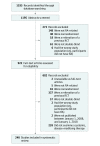Demographic Characteristics of Participants in Rheumatoid Arthritis Randomized Clinical Trials: A Systematic Review
- PMID: 31722023
- PMCID: PMC6902779
- DOI: 10.1001/jamanetworkopen.2019.14745
Demographic Characteristics of Participants in Rheumatoid Arthritis Randomized Clinical Trials: A Systematic Review
Abstract
Importance: Racial/ethnic minority groups, women, and elderly people experience a disproportionate burden of disease in rheumatoid arthritis (RA), making it particularly important to examine drug therapies in these populations. Despite a national health agenda to improve representation of diverse populations in randomized clinical trials (RCTs), there have been few large-scale analyses examining RCT demographic characteristics within rheumatology and none focusing on RA.
Objective: To characterize the representation of racial/ethnic minority groups, women, and elderly people through a comprehensive systematic review of RA RCTs.
Data sources: A literature search of PubMed's MEDLINE database was conducted to identify RA RCTs in adults 19 years and older published in English between January 1, 2008, and January 1, 2018.
Study selection: Randomized double-blind RCTs examining any systemic, disease-modifying therapy were included. Secondary analyses of previously published RCTs were excluded. Of 1195 identified records, 240 articles (20.1%) met final selection criteria. The analysis focused on RCTs with at least 1 US-based site.
Data extraction and synthesis: Data were extracted and synthesized according to the PRISMA guidelines for systematic reviews. Studies were screened for eligibility criteria. Demographic data on the age, sex, and race/ethnicity of RCT participants were extracted. Data analysis was conducted from October 25, 2018, to March 15, 2019.
Main outcomes and measures: Representation of race/ethnicity and sex, defined as the proportion of total participants that belonged to each racial/ethnic group or sex. Trends in proportions over time were examined and compared with US demographic data.
Results: A total of 240 RCTs with 77 071 participants were included. Of 126 RCTs with at least 1 US-based site (52.5%), the enrollment of minority racial/ethnic groups was significantly lower than their representation within the US Census population (16% vs 40%; P < .001), and the enrollment of men was significantly lower than the incidence of RA in men nationally (20.4% vs 28.6%; P < .001). There was no trend toward improved representation of racial/ethnic minority groups or men over time.
Conclusions and relevance: Given the disproportionate burden of RA among racial/ethnic minority groups, it is imperative that policy makers better incentivize the inclusion of racial/ethnic minority groups in RA RCTs.
Conflict of interest statement
Figures




References
-
- National Institute of Arthritis and Musculoskeletal and Skin Diseases Who gets rheumatoid arthritis? https://www.niams.nih.gov/health-topics/rheumatoid-arthritis/advanced#ta.... Updated April 30, 2017. Accessed August 4, 2018.
-
- Iren UT, Walker MS, Hochman E, Brasington R. A pilot study to determine whether disability and disease activity are different in African-American and Caucasian patients with rheumatoid arthritis in St. Louis, Missouri, USA. J Rheumatol. 2005;32(4):-. - PubMed
-
- Bruce B, Fries JF, Murtagh KN. Health status disparities in ethnic minority patients with rheumatoid arthritis: a cross-sectional study. J Rheumatol. 2007;34(7):1475-1479. - PubMed
Publication types
MeSH terms
Grants and funding
LinkOut - more resources
Full Text Sources
Medical
Miscellaneous

